考研英语定语从句典型例句剖
定语从句经典例句20个
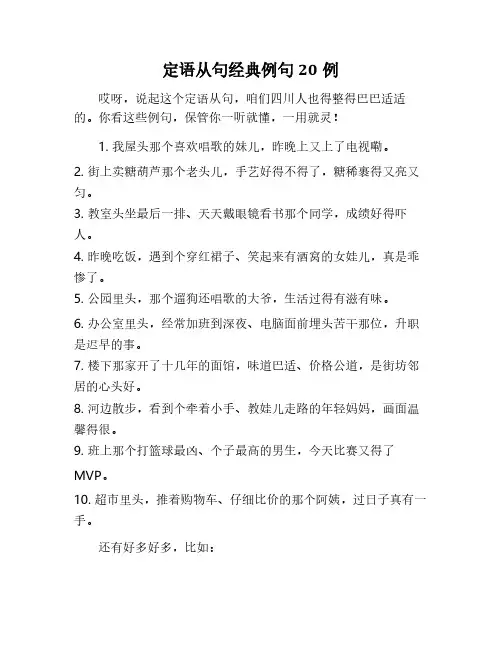
定语从句经典例句20例
哎呀,说起这个定语从句,咱们四川人也得整得巴巴适适的。
你看这些例句,保管你一听就懂,一用就灵!
1.我屋头那个喜欢唱歌的妹儿,昨晚上又上了电视嘞。
2.街上卖糖葫芦那个老头儿,手艺好得不得了,糖稀裹得又亮又匀。
3.教室头坐最后一排、天天戴眼镜看书那个同学,成绩好得吓人。
4.昨晚吃饭,遇到个穿红裙子、笑起来有酒窝的女娃儿,真是乖惨了。
5.公园里头,那个遛狗还唱歌的大爷,生活过得有滋有味。
6.办公室里头,经常加班到深夜、电脑面前埋头苦干那位,升职是迟早的事。
7.楼下那家开了十几年的面馆,味道巴适、价格公道,是街坊邻居的心头好。
8.河边散步,看到个牵着小手、教娃儿走路的年轻妈妈,画面温馨得很。
9.班上那个打篮球最凶、个子最高的男生,今天比赛又得了MVP。
10.超市里头,推着购物车、仔细比价的那个阿姨,过日子真有一手。
还有好多好多,比如:
11.书店角落头,看科幻小说看得入迷、时不时还皱眉头的小伙子,肯定是科幻迷。
12.路上遇到的,牵着盲人爷爷过马路的那个小女孩,心地善良得很。
13.夜市里头,摆摊卖手工饰品、手艺精巧的那个小姐姐,每件作品都是独一无二。
这些个例句,都是咱们生活中常见的场景,用四川话一讲,是不是觉得更亲切、更容易理解了呢?定语从句,其实就这么简单!。
定语从句高级例句
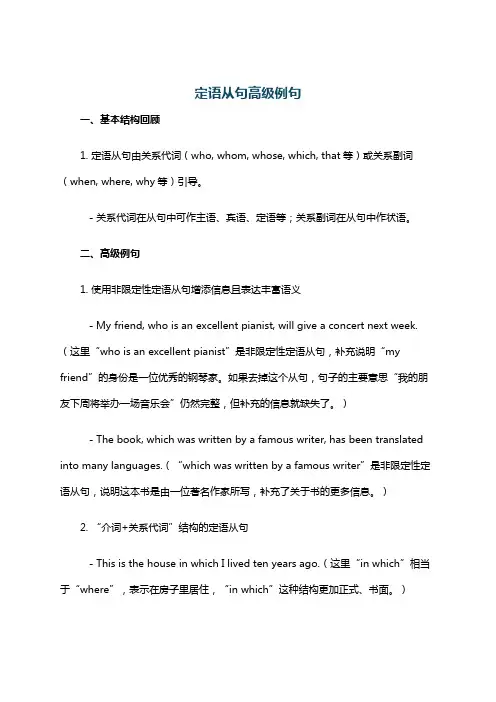
定语从句高级例句一、基本结构回顾1. 定语从句由关系代词(who, whom, whose, which, that等)或关系副词(when, where, why等)引导。
- 关系代词在从句中可作主语、宾语、定语等;关系副词在从句中作状语。
二、高级例句1. 使用非限定性定语从句增添信息且表达丰富语义- My friend, who is an excellent pianist, will give a concert next week.(这里“who is an excellent pianist”是非限定性定语从句,补充说明“my friend”的身份是一位优秀的钢琴家。
如果去掉这个从句,句子的主要意思“我的朋友下周将举办一场音乐会”仍然完整,但补充的信息就缺失了。
)- The book, which was written by a famous writer, has been translated into many languages.(“which was written by a famous writer”是非限定性定语从句,说明这本书是由一位著名作家所写,补充了关于书的更多信息。
)2. “介词+关系代词”结构的定语从句- This is the house in which I lived ten years ago.(这里“in which”相当于“where”,表示在房子里居住,“in which”这种结构更加正式、书面。
)- The man with whom I talked just now is my teacher.(“with whom”表示和某人谈话,这种结构比“whom I talked with”更显高级。
)3. 关系代词as引导的定语从句- As is known to all, the earth is round.(“as”在这里引导非限定性定语从句,指代整个句子“the earth is round”,可放在句首,表示“众所周知”。
考研英语长难句:定语从句
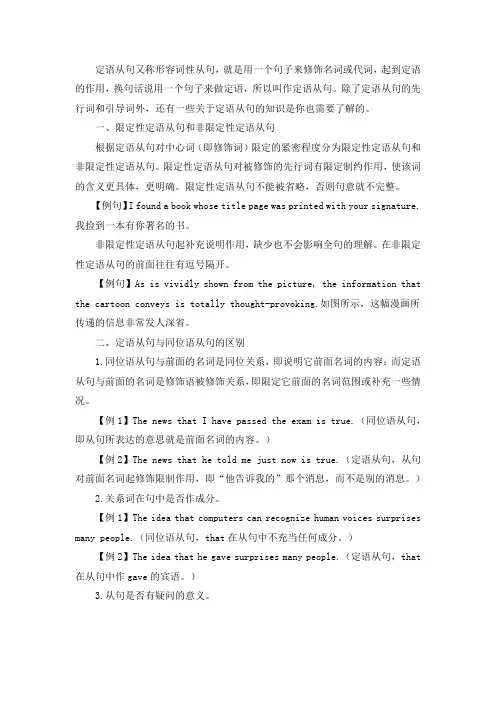
定语从句又称形容词性从句,就是用一个句子来修饰名词或代词,起到定语的作用,换句话说用一个句子来做定语,所以叫作定语从句。
除了定语从句的先行词和引导词外,还有一些关于定语从句的知识是你也需要了解的。
一、限定性定语从句和非限定性定语从句根据定语从句对中心词(即修饰词)限定的紧密程度分为限定性定语从句和非限定性定语从句。
限定性定语从句对被修饰的先行词有限定制约作用,使该词的含义更具体,更明确。
限定性定语从句不能被省略,否则句意就不完整。
【例句】I found a book whose title page was printed with your signature.我捡到一本有你署名的书。
非限定性定语从句起补充说明作用,缺少也不会影响全句的理解。
在非限定性定语从句的前面往往有逗号隔开。
【例句】As is vividly shown from the picture, the information that the cartoon conveys is totally thought-provoking.如图所示,这幅漫画所传递的信息非常发人深省。
二、定语从句与同位语从句的区别1.同位语从句与前面的名词是同位关系,即说明它前面名词的内容;而定语从句与前面的名词是修饰语被修饰关系,即限定它前面的名词范围或补充一些情况。
【例1】The news that I have passed the exam is true.(同位语从句,即从句所表达的意思就是前面名词的内容。
)【例2】The news that he told me just now is true.(定语从句,从句对前面名词起修饰限制作用,即“他告诉我的”那个消息,而不是别的消息。
)2.关系词在句中是否作成分。
【例1】The idea that computers can recognize human voices surprises many people.(同位语从句,that在从句中不充当任何成分。
考研英语【定语从句】典型例句剖
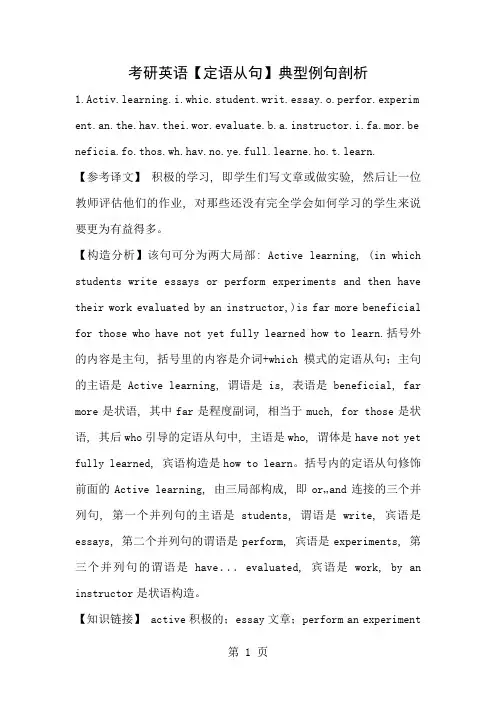
考研英语【定语从句】典型例句剖析1.Activ.learning.i.whic.student.writ.essay.o.perfor.experim ent.an.the.hav.thei.wor.evaluate.b.a.instructor.i.fa.mor.be neficia.fo.thos.wh.hav.no.ye.full.learne.ho.t.learn.【参考译文】积极的学习, 即学生们写文章或做实验, 然后让一位教师评估他们的作业, 对那些还没有完全学会如何学习的学生来说要更为有益得多。
【构造分析】该句可分为两大局部: Active learning, (in which students write essays or perform experiments and then have their work evaluated by an instructor,)is far more beneficial for those who have not yet fully learned how to learn.括号外的内容是主句, 括号里的内容是介词+which模式的定语从句;主句的主语是Active learning, 谓语是is, 表语是beneficial, far more是状语, 其中far是程度副词, 相当于much, for those是状语, 其后who引导的定语从句中, 主语是who, 谓体是have not yet fully learned, 宾语构造是how to learn。
括号内的定语从句修饰前面的Active learning, 由三局部构成, 即or…and连接的三个并列句, 第一个并列句的主语是students, 谓语是write, 宾语是essays, 第二个并列句的谓语是perform, 宾语是experiments, 第三个并列句的谓语是have...evaluated, 宾语是work, by an instructor是状语构造。
定语从句例句带翻译及讲解
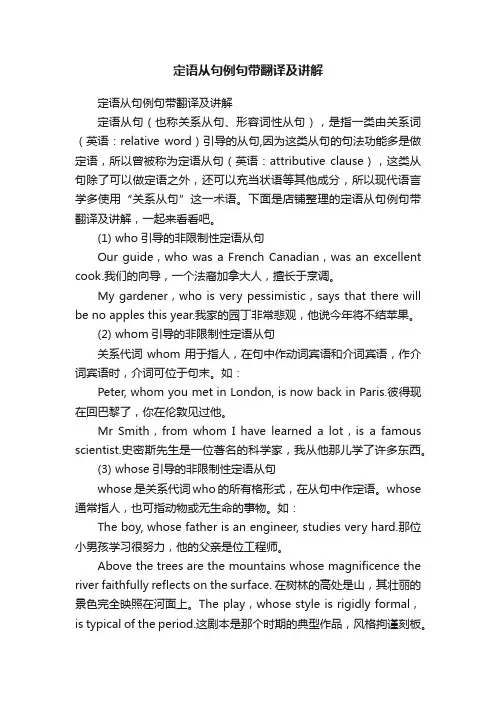
定语从句例句带翻译及讲解定语从句例句带翻译及讲解定语从句(也称关系从句、形容词性从句),是指一类由关系词(英语:relative word)引导的从句,因为这类从句的句法功能多是做定语,所以曾被称为定语从句(英语:attributive clause),这类从句除了可以做定语之外,还可以充当状语等其他成分,所以现代语言学多使用“关系从句”这一术语。
下面是店铺整理的定语从句例句带翻译及讲解,一起来看看吧。
(1) who引导的非限制性定语从句Our guide,who was a French Canadian,was an excellent cook.我们的向导,一个法裔加拿大人,擅长于烹调。
My gardener,who is very pessimistic,says that there will be no apples this year.我家的园丁非常悲观,他说今年将不结苹果。
(2) whom引导的非限制性定语从句关系代词whom用于指人,在句中作动词宾语和介词宾语,作介词宾语时,介词可位于句末。
如:Peter, whom you met in London, is now back in Paris.彼得现在回巴黎了,你在伦敦见过他。
Mr Smith,from whom I have learned a lot,is a famous scientist.史密斯先生是一位著名的科学家,我从他那儿学了许多东西。
(3) whose引导的非限制性定语从句whose是关系代词who的所有格形式,在从句中作定语。
whose 通常指人,也可指动物或无生命的事物。
如:The boy, whose father is an engineer, studies very hard.那位小男孩学习很努力,他的父亲是位工程师。
Above the trees are the mountains whose magnificence the river faithfully reflects on the surface. 在树林的高处是山,其壮丽的景色完全映照在河面上。
定语从句例句带翻译及讲解【优秀7篇】
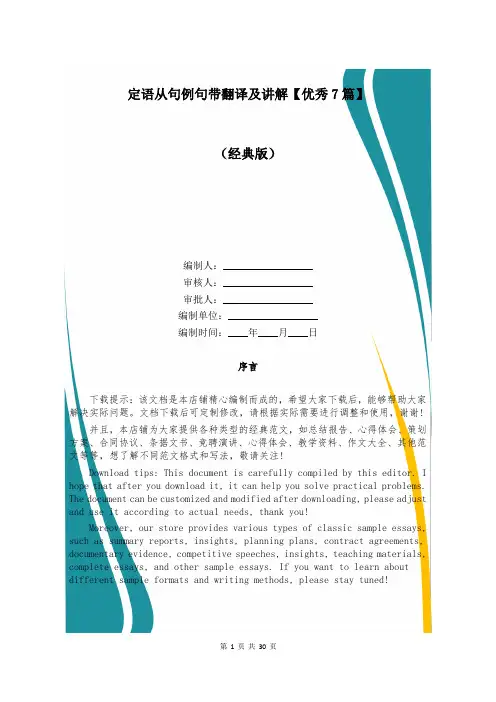
定语从句例句带翻译及讲解【优秀7篇】(经典版)编制人:__________________审核人:__________________审批人:__________________编制单位:__________________编制时间:____年____月____日序言下载提示:该文档是本店铺精心编制而成的,希望大家下载后,能够帮助大家解决实际问题。
文档下载后可定制修改,请根据实际需要进行调整和使用,谢谢!并且,本店铺为大家提供各种类型的经典范文,如总结报告、心得体会、策划方案、合同协议、条据文书、竞聘演讲、心得体会、教学资料、作文大全、其他范文等等,想了解不同范文格式和写法,敬请关注!Download tips: This document is carefully compiled by this editor. I hope that after you download it, it can help you solve practical problems. The document can be customized and modified after downloading, please adjust and use it according to actual needs, thank you!Moreover, our store provides various types of classic sample essays, such as summary reports, insights, planning plans, contract agreements, documentary evidence, competitive speeches, insights, teaching materials, complete essays, and other sample essays. If you want to learn about different sample formats and writing methods, please stay tuned!定语从句例句带翻译及讲解【优秀7篇】所谓定语从句,就是在复合句中起定语作用以修饰主句中的名词或代词的从句。
英语定语从句举例
英语定语从句举例
1. The book that I borrowed from the library is fascinating.
我从图书馆借的那本书很吸引人。
2. She is the teacher who inspired me to love science.
她是那位激励我热爱科学的老师。
3. The car that he bought last year is very fast.
他去年买的那辆车非常快。
4. This is the restaurant where we had our first date.
这就是我们第一次约会的餐厅。
5. The movie that I watched last night was thrilling.
我昨晚看的那部电影很刺激。
6. I have a friend who can speak five languages.
我有一个能说五种语言的朋友。
7. The flowers that you gave me are still blooming.
你送我的花仍然在盛开。
8. He is the musician whose songs I admire the most.
他是我最欣赏的音乐家。
9. The house that we visited last summer was beautiful.
我们去年夏天参观的那座房子很漂亮。
10. I found a wallet that was lying on the ground.
我在地上发现了一个钱包。
考研英语语法(从句)详细解析总结(含例句)
考研英语语法(从句)详细解析总结(含例句)(一)英语从句的原理1.我们已经学习过句子的成分【参考句子成分讲义】当一个完整的句子A成为另一个句子B的某一成分时,A就变成了从句●eg. I know that you are hard-working!我知道你们很努力●完整的句子A { you are hard-working } 就叫做从句,在主句 B [I know A]中作宾语➡️A随从/服从B2.英语的三种句子●简单句:不能再拆分的句子【参考简单句讲义】●复杂句:也叫做并列句,两个句子不分主次,仅仅逻辑关系词连接and、but、however,,,●eg. I like apples,and he likes bananas. = He likes bananas,and I like apples.●复合句:主从复合句,主句 + 从句,两个句子有主次关系(二)英语从句的分类所以有哪些句子成分就会有哪些从句类型:除了英语的核心动词之外,其他所有句子成分都可以有从句1.①形容词从句 = 定语从句 = 关系从句➡️英语从句中最重要的;内容最多的;最难的一类从句●概念●对某个人或者事物进行描述,具有形容词性质➡️形容词性从句●在句子中充当定语这个成分,起修饰作用➡️定语从句●构成往往需要关系词来引导➡️关系从句●形容词从句的思维方式●中文思维:形容词都放在被修饰词之前,即形容词/句子 + 的eg. 好吃的苹果;努力学习的他们●英语思维●单个词修饰时,也放在被修饰词之前eg. a tasty apple●用一句话来修饰时,就需要在被修饰词后面 + 一个与它有关系的词 + 另一个句子,即先行词 + 关系词 + 定语从句●思维对比:这也是我们在翻译时不能逐字逐句顺序进行的原因,定语从句就需要逆序先翻译●中文:兔子在吃一根我买来的胡萝卜【前置】●英语:兔子在吃一根胡萝卜(胡萝卜的关系词)我买的【后置】The rabbit is eating a carrot that I bought.●形容词从句的构成:关系词(引导定语从句)●关系代词:引导词起指代、替代的作用●方法:陈述句语序中,被修饰词更换为关系代词➡️把关系代词放到开头,就变成了从句●that(那):The rabbit is eating a carrot that I bought.I bought that →that I bought●who(主语):The student who is reading is my friend.who is reading →who is reading●whom(宾语):The student whom I taught is my friend.I taught whom →whom I taught●whose(ta的):The student whose bag is pink is my friend.whose bag is pink →whose bag is pink●which(那个):The student which is reading/I taught is my friend.which is reading/I taught which →which is reading/I taught●that & which:指代人或物(主语宾语都可以),经常可以互换●先行词唯一:that●eg. The rabbit ate the biggest carrot that I 've ever seen. 兔子吃了我见过最大的胡萝卜●the biggest已经限定了先行词是唯一的,所以只能用that●先行词多选一:which●eg. The rabbit is eating a carrot that/which I bought.●我买了很多根胡萝卜,兔子吃的只是其中随便一根●关系副词:引导词的词性是副词关系副词 = 介词 + 关系代词●where(地点):This is the place where I study.●why(原因):This is the reasin why I study.●when(时间):That was the day when I met him.●形容词从句的限定性和非限定性●通过前面的学习,大家已经明白了定语从句的主要功能就是修饰限定范围,所以限定性和非限定性的区别即:是否限定了先行词的范围/性质●限定性定语从句●上述例句均为限定性定语从句:全部都限制了先行词的范围●非限定性定语从句:通常有逗号隔开,作插入语补充信息●eg. I read the book,which is on the desk. 我读了本书,那本书在桌子上(有种接着说,补充说明的意思)●eg. My head,which is big,is useful when it rains. 我有大头下雨不愁(作插入语补充信息,即使删去也不影响原句子完整)●eg. Rabbits eat carrots, which is not surprising. 兔子吃胡萝卜,这事不稀奇(甚至可以指代一个完整的句子进行修饰)2.②名词从句●引导词:相当于一个信号告诉你“那么接下来从句要开始咯!”注意:引导词在从句开头;从句是陈述句语序●that:确定信息●whether;where;when;how;who;what:不确定信息●主语从句:将句子中的主语变成从句的形式●正常语序:主语放在句子最开头●eg. That rabbits eat carrots is obvious.●eg. Whether rabbits eat carrots is obvious. 是否吃●eg. Where rabbits eat carrots is obvious. 在哪吃●eg. When rabbits eat carrots is obvious. 什么时候吃●eg. Who eats carrots is obvious. 谁吃●eg. What rabbits eat is obvious. 吃什么●eg. How rabbits eat carrots is obvious. 怎么吃●形式主语:it指代主语从句,it本身没有什么意义【翻译时,可以拆成两句或是倒序先翻译主语从句】英语句子的主语从句过长就会头重脚轻,所以会改个形式说出来●eg. It is obvious that rabbits eat carrots. 很明显,兔子吃胡萝卜/兔子吃胡萝卜这事儿很明显●eg. It is obvious whether rabbits eat carrots.●可自行练习改写上述例句●表语从句:将句子的表语变成从句的形式●eg. The reason is that you need to study.●eg. It feels that you like me.●同位语从句:将句子的同位语变成从句的形式●一般修饰抽象名词:the fact;the idea...●eg. The question that/whether rabbits eat carrots is interesting.●宾语从句:从句作句子的宾语●确定信息&不确定信息●eg. I know that rabbits eat carrots.●eg. I know whether/where/... rabbits eat carrots.●宾语从句引导词that往往可以省略,注意判断●eg. I know rabbits eat carrots.●宾语从句的否定●在谓语动词前否定,而非在从句中,否则会有句意的改变●eg. I don't know rabbits eat carrots.●eg. I don't think rabbits eat carrots.●eg. I don't believe rabbits eat carrots.●主从时态一致,但从句描述客观规律例外●eg. I knew you gratuated last year.●eg. I knew the sun rises in the east.●宾补从句:从句作句子的宾语补足语●使用较少●eg. You can call me whatever you like. 你随便怎么称呼我都可以●eg. My parents made me who I am.3.③副词从句 = 状语从句英语从句中种类最多的➡️因为补充说明的可能性最多●概念●在句中起到副词的作用,一般补充说明动词、形容词、副词等➡️副词从句●句子成分上说,充当了句子的状语➡️状语从句●时间状语从句●在某一时间点之前:before●eg. I cleaned the room before you came.●= Before you came, I cleaned the room.●在某一时间点之中●when:强调在某个时间点●eg. I was watching TV when my mom came home. 当我妈妈回家时,我正在看电视●= When my mom came home,I was watching TV.●while:强调在一个时间段内●eg. I was watching TV while my mom was cooking. 我妈妈做饭时,我在看电视●= While my mom was cooking,I was watching TV.●as:强调同时进行的两个动作●eg. My mom cooked as she watched TV. 我妈妈一边做饭一边看电视●= As my mom watched TV,she cooked.●在某一时间点之后:after●eg. I go to school after I get up.●= After I get up,I go to school.●从之前某一时间点开始算起的一个时间段,往往暗示了对之后有影响(完成时态)since●eg. I have read two books since my mom came home. 自从我妈妈回家以后,我已经看了两本书了●直到之后的某一时间点:until●eg. I waited until my mom came home. 我一直在等,直到妈妈回家●not,,,until,,,:直到,,,才,,,(注意翻译方法)●eg. I didn't go to sleep until my mom came home. 直到我妈妈回家我才睡觉●一个动作紧跟着另一个动作发生:as soon as(注意翻译顺序:一,,,就,,,)●eg. It rained as soon as we went to schoo. 我们一去上学,就下雨了●下次,,,:the next time●eg. I will hug you the next time we meet. 下次我们见面时我一定会拥抱你●地点状语从句●引导词:where●eg. I read books where I study.●强调形式:wherever不管哪里;everywhere所有地方;anywhere任何地方●eg. I read books wherever/everywhere/anywhere I can sudy.●条件状语从句从句比主句落后一个时态●真实条件句:真实的假设 if●eg. If the rabbit sees a carrot,it will eat it.●虚假的假设:if【参考虚拟语气讲义】●否定条件句:unless 除非,,,否则/不然●eg. Unless it rains,the game will be played. 除非下雨,比赛将正常进行●= If it doesn't rain,the game will be played.●其他引导词:as long as只要;in case如果●eg. You may borrow my book as long as you keep it clean. 只要你保持书的清洁,你就可以把我的书借去。
考研英语语法 定语从句详解附译文
考研英语语法定语从句详解附译文定语从句是中国人学英语最重要的难点之一。
其实定语从句很有规律,总结如下:在关系代词中that既可指人又可指物、既可作主语又可作宾语,因此,除了在非限定性定语从句中,用that一般不会出问题。
关系副词的用法比较单一,它们从句中只起状语的作用,表示时间的就用who,表示地点的就用where,而why只修饰一个词,即reason。
定语从句所修饰的词叫“先行词”,因为它总是处在定语从句的前头,比定语从句先行一步。
引导定语从句的词叫关系词,包括关系代词和关系副词。
•关系代词:who,which,that作从句的主语whom,which,that作从句的宾语(可省略)whose从句中作定语以下情况只能用that,不能用which:i.先行词为不定代词all, little, none,any,every,no,much, anything, nothingii. 先行词有最高级和序数词修饰时(包括: the only, the very, the same, the last, the next等)iii.先行词既有人又有物的时候以下情况只能用which,不能用that;①引导非限制性定语从句(包括代表整个主句的意思时)②介词+关系代词的结构中•关系副词:when指时间,在定语从句中作时间状语where指地点,在定语从句中作地点状语why指原因,在定语从句中作原因状语,只修饰reason。
如果用定语从句把两个句子合二为一:首先找出两个句子当中相同的部分,定语从句修饰的就是这一部分。
要把其中一个句子变成定语从句,就要把这句中相同的那个部分用一个关系词来代替; 代替时,先看被代替的部分是指人还是指物、再看它作什么句成分。
指人并作主语的,就用who。
或that; 指人并作宾语的,就用whom或that; 指人并作定语的,就用whose。
指物并作主语的,就用which或that; 指物并作宾语的,还是用which或that; 指物并作定语的,就用whose或of which。
经典定语从句例句20句
经典定语从句例句20句在复合句中作定语,修饰主句中的某一名词或代词的从句,叫做定语从句。
被定语从句所修饰的词叫先行词,位于从句之前。
定语从句有关系代词that、which、who、whose、whom和关系副词when 、where、why引导. 今天,小编为大家带来一大波例句,一起来看看吧!1. This is an old computer which\that works much slower.2. They stayed with me for three weeks during which time they drunk all the wine I had.3. The picture (that) we are looking at was drawn by a fifteen-year-old student.4. The picture at which we are looking was drawn by a fifteen-year-old student.5. I have many students to whom I am going to send postcards.6. You’re the only one whose advice he might listen to.7. I’d like a room whose window looks out over the sea.8. The explorer took only such men and things as he really needed into the jungle.9. Such people as have made great contributions to the world should be greatly respected.10. Let’s meet at the same place as we did yesterday.11. Shakespeare is a famous writer ,as everyone knows.12. As everyone knows ,Shakespeare is a famous writer.13. Shakespeare ,as everyone knows ,is a famous writer.14. Potato can be grown in places where(in which)it’s too cold to grow rice.15. I shall never forget the days when(on which)we worked on the farm.16. Can you tell me the reason why(for which) the car broke down.17. The reason that the car broke down caused the accident.18. He told me the way (that\in which)he solved the problem.19. He told me how to solve the problem.20. I have been to the places (that\where\in which)the Indians live.以上就是有关定语从句例句的内容了。
- 1、下载文档前请自行甄别文档内容的完整性,平台不提供额外的编辑、内容补充、找答案等附加服务。
- 2、"仅部分预览"的文档,不可在线预览部分如存在完整性等问题,可反馈申请退款(可完整预览的文档不适用该条件!)。
- 3、如文档侵犯您的权益,请联系客服反馈,我们会尽快为您处理(人工客服工作时间:9:00-18:30)。
考研英语定语从句典型例句剖————————————————————————————————作者: ————————————————————————————————日期:ﻩ考研英语【定语从句】典型例句剖析1. Activelearning,inwhich studentswriteessays orperform experiments and thenhave their work evaluated by an instructor, is far more beneficialfor those who have not yet fully learnedhow to learn.【参考译文】积极的学习,即学生们写文章或做实验,然后让一位老师评估他们的作业,对那些还没有完全学会如何学习的学生来说要更为有益得多。
【结构分析】该句可分为两大部分:Activelearning, (in whichstudents write essays or perform experimentsandthen have their work evaluated by an instructor,)isfar morebeneficialforthose whohave notyet fullylearned how tolearn.括号外的内容是主句,括号里的内容是介词+which模式的定语从句;主句的主语是Activelearning,谓语是is,表语是beneficial,far more 是状语,其中far是程度副词,相当于much,for those是状语,其后who引导的定语从句中,主语是who,谓体是have notyet fully learned,宾语结构是howto learn。
括号内的定语从句修饰前面的Activelearning,由三部分构成,即or…and连接的三个并列句,第一个并列句的主语是students,谓语是write,宾语是essays,第二个并列句的谓语是perform,宾语是experiments,第三个并列句的谓语是have...evaluated,宾语是wor k,byan instructor是状语结构。
【知识链接】active积极的;essay文章;perform an experiment做实验;evalua te评估instructor指导者,老师;be beneficialfor...对……有益。
2. The American version of the"idealindividual" prefersan atmosphere of f reedom, whereneither the government nor any other externalforce orag encydictateswhatthe individual does.【参考译文】美国版的“理想个人”更喜欢一种自由的氛围,在这种氛围中政府或者任何别的外部力量都不会强行规定个人该做什么。
【结构分析】该句可分为两大部分:(The Americanversionof the"ideal indiv idual"prefers an atmosphere of freedom,)(whereneither the government norany other external force or agency dictateswhat the individualdoes.),第一部分是主句,第二部分是以where引导的非限定定语从句,修饰前面的atmosphere;主句的主语是The American version,谓语是prefers,宾语是an atmosphere,of the“idealindividual”作version的后定语,of freedom作atmosphere的后定语;第二部分的主语是由neither...nor…or...连接的并列名词短语,谓语是dictates,宾语是what引导的从句。
【知识链接】version版本;ideal理想的;prefer更喜欢,联想记忆:prefer...to...宁要……而不要……;atmosphere氛围;external外部的,联想记忆:internal内部的;agency 机构;dictate命令,强制规定。
3.Conflict,definedas oppositionamongsocial entitlesdirectedag ainsteach other, isdistinguished from competition, defined as opposition amongsocial entitlesindependently strivingforsomething whichis in inadequatesupply.【参考译文】冲突不同于竞争,前者指彼此对立的社会群体间的对抗,后者指独自争夺匮乏资源的社会群体间的对抗。
【结构分析】该句可分为三部分:Conflict,(definedasopposition among social entities directed against eachother, )is distinguishedfrom competition,(defined asopposition amongsocialentities independently strivingfor something whichis ininadequate supply.),括号外的内容Conflict...isdistingui shedfrom competition是主句,Conflict是主语,is是谓语,distinguished from competition是表语;两个括号里的内容均是过去分词短语,分别作前面Conflict和competition的后置定语;第一个定1/9页语结构中前省略了whichis,谓语是be defined as,宾语是opposition,介词短语among socialentities作前面opposition的定语,directedagainsteachot her是过去分词+介词短语结构,作前面socialentities的定语;第二个定语结构的前半部分与第一个完全相同,strivingforsomething是现在分词短语,作social entities的定语,independently作strivefor的状语,最后的which引导somethi ng的定语从句,ininadequate supply是is的表语结构。
这个句子翻译时要先译主句,然后再分别译两个后置定语结构。
【知识链接】conflict冲突;bedefined as...被定义为……;opposition对立,对抗; entities实体,群体;be directedagainst...与....对立;be distinguished from...与....不同;competition竞争;independently独立地,独自地;strivefor...追求……;sth.isinsupply供应……;inadequate不充足的,匮乏的,联想记忆:adequate充足的,充分的。
4.The resulting situation--inwhich mostpeople would notbeworking in their jobs for morethan twoor three shortdays a week--could hardly continue to be one in whichemployment was still regardedas theonly truly validformofwork.【参考译文】最终的情形将是:大多数人在其岗位上的工作时间一周内不会超过短短的两三天,这将使得就业不再被视作唯一真正有效的工作方式。
【结构分析】该句可分为三大部分:The resultingsituation-- (in whichmos tpeople wouldnot be working intheir jobs for more than two or three sho rtdays a week)—could hardly continue tobe one(in whichemployment wasstillregarded as theonly trulyvalidform ofwork.);括号外的内容是主句,即The resulting situation...could hardly continue to beon e,其中的one指代前面的situation;两个括号里的内容均是定语从句;第一个定语从句属于介词in+关系代词which的模式,其中which指代前面的situation,该从句的主语是employment,谓语是was regarded as,宾语是the...form ofwork;第二个括号里的定语从句与第一个定语从句的结构相同,修饰前面的one,该从句的主语是mostpeople,谓语是wouldnotbeworking,in theirjobs作地点状语,for more thantwo or three shortdays a week作时间状语。
翻译时要将主句的否定词hardly后移至was和regarded as之间,才会顺畅自如。
【知识链接】resulting最终的;employment就业,联想记忆:unemployment失业;be regardedas...被认为是……;valid有效的,联想记忆:invalid无效的;form of wor k工作方式。
5.The coming ofageofthe postwarbabyboom and an entry into the male-dominatedjob markethavelimited theopportunities ofteenagers who arealready questioningthe heavy personal sacrifices involvedin climbing Japan’s rigid social ladder to good schoolsand jobs.【参考译文】随着战后生育高峰期出生的孩子长大成人,以及妇女进入男性主宰的就业市场,限制了青少年的发展机遇。
